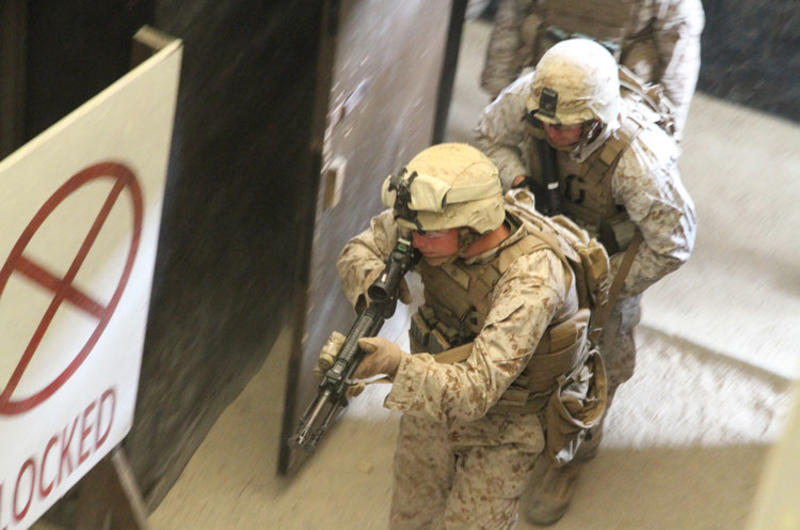By Blood and fire near the DMZ | Matthew M. Burke October 1, 2015
RODRIGUEZ LIVE FIRE COMPLEX, South Korea — A flurry of rockets, belt-fed machine guns, mortars and anti-tank missiles served as a fireworks crescendo for India Company’s six-month rotational deployment to Asia.
When the smoke settled June 9 at the Rodriguez Live Fire Complex near the Korean Demilitarized Zone, the Marine riflemen from 3rd Battalion, 2nd Marine Regiment reflected on how far they had come since February in their Unit Deployment Program.
The Camp Lejeune-based grunts had experienced incessant rains and smothering humidity, wind-whipped sleet and snow, and now, searing heat.
They slept inside — in beds, for a change — and they had slept outside on hard ground. There had been stretches without showers, and times when doing laundry meant putting filthy clothes in a plastic bag with some detergent and water and shaking it up.
Then there were the daily physical challenges that Marines embrace as the price of combat — or at least, as the chance to fire weapons.
The 3-2 arrived in Okinawa, Japan, in February for the program, which brings stateside Marine units to Asia on rotational deployments. In March, they learned jungle survival skills at the Jungle Warfare Training Center in Okinawa’s remote north. In April, they went to Camp Fuji, a small Marine base at the bottom of Japan’s tallest peak.
Now, on their final stop before heading home in August, they were in South Korea, in the shadow of the world’s most heavily militarized border.
Fighting boredom
Rodriguez, a tiny joint Army and South Korean base in a flat valley surrounded by towering mountains, features barracks, a live-fire shoot house and myriad ranges that can support anything from air strikes to artillery.
That’s the action.
But with nothing else for miles, extreme boredom set in during frequent downtimes during the program. Delays came from all the units itching to train on a limited number of ranges: stringent safety protocols; and very strict range control that took weather and other factors into account before authorizing a live-fire shoot.
The 3-2 could only run and lift weights so much, or watch so many “True Blood” or “Vikings” TV episodes. So some entertained themselves with a guitar and a hacky sack made from items found in their barracks. Others congregated to make fun of one another, create over-the-top comedy sketches and brag about sex and fights. They made up games to embarrass each other or even cause pain.
“There’s really no other way to put that other than it’s just something you get used to,” said Lance Cpl. Jacob Mathes. “I would say, to pass the time, Marines have the best games. They can make a game out of anything.
“You’re all suffering together, and I guess that is the main thing that brings everyone together. … I know any other normal person would look at us like we’re crazy, but it is what it is, I guess.”
Bayonet to the face
Shortly after arriving at Rodriguez, India Marines got their feet wet with some live-fire training but were forced to stop when a forest fire was sparked by munitions. No sooner had they returned to the barracks than training began again.
An improvised explosive device refresher course included the invisible risks near the DMZ.
“There’s a lot of minefields out there,” the instructor said, explaining that in a small nearby area about twice the size of the barracks where the class was held, 500 anti-personnel mines were discovered.
The following day, the 3rd Platoon Marines headed to the seven-room live-fire shoot house, with straight and winding hallways and numerous hiding “enemies” – hard-rubber dummies in camouflage and civilian attire. The house was fitted with a catwalk overhead for viewing by company leadership.
Third Platoon spent the better part of the morning in flaks and Kevlar — but without ammunition.
“Bang bang,” an intensely focused Sgt. Donald Horn, 3rd Platoon squad leader, said as he entered a room and went right, aiming his M4 rifle at a bullet-pocked dummy. He was followed by Cpl. Logan Hampton, a dedicated former presidential guard at Camp David and fire team leader, who went left.
“Bang bang,” Hampton said. “Two Marines exiting.”
Then the pair switched.
Horn, a combat veteran of multiple Afghanistan tours, had been trying to mentor some of the fire team and squad leaders in the platoon. Their leadership and proficiency are paramount to the 3-2’s future success.
Third Platoon’s three squads went through dry runs for what seemed like hours, adding rooms, shooters and Marines into the stack as they mastered simpler prerequisites.
Once their leadership — Staff Sgt. Mark Mlachak and 1st Lt. Matthew Mannion — and range officers Staff Sgt. Thomas Ochoa and 1st Lt. William Godwin were satisfied, they collected live ammunition, loaded their magazines and got back to work.
“Doorway right, two targets, one shooter,” Godwin bellowed as Horn lined up in a short stack outside the room behind Cpl. Curtis Beam, another squad leader, placing his hand on Beam’s shoulder as a way of communicating.
They quickly entered the room, flicking off their safeties and taking aim; red dots on chests, center mass.
“Boom, boom! Boom, boom!” Beam’s rifle echoed.
“Left side clear!” he yelled.
“Right side clear!” Horn shouted. The Marines clicked their rifles back on safe.
Then came the next team.
When Horn wasn’t leading by example, he would follow the men of 3rd Platoon into the shoot house rooms, watching for ways the men could improve their performance.
Lance Cpl. Jordan Carbo slid around the doorframe and pulled his rifle trigger. Nothing happened.
“I got a jam,” he announced as his eyes wandered from the target to his weapon.
“Bayonet to the face,” someone yelled from the gallery above.
Carbo slammed his rifle into the dummy’s face in a fluid motion.
Later, Godwin, Mannion and Mlachak stopped the training after several Marines moved back from their targets, firing as they entered a room instead of charging toward them. This could allow a fellow Marine to walk into their line of fire.
The mistake was corrected in true Marine fashion — much cursing and derision.
Steadily, the trainers added shooters and rooms, making the clearing more and more complex.
Fire for effect
Later that afternoon, 3rd Platoon went through a call-for-fire refresher officiated by company executive officer 1st Lt. Phillip Richard.
Horn’s squad broke off to take its turn in a simulator to apply what the members had just learned.
The simulator featured maps, optics and screens that depicted approaching tanks or vehicles on a road. The Marine forward observers could control the type, size and amount of ordnance dropped.
Lance Cpl. Andrew Luna spotted three vehicle targets on a road along the horizon and called out their location for a strike. Richard stopped him because he had made some minor errors with the meticulous instructions. After walking through it with Richard, Luna made adjustments. Six successive rounds pounded the target.
Maximize the opportunity
On the eve of the deployment’s biggest exercise, three India Company lance corporals were promoted. Friends pinned on their new corporal insignias. Company commander Capt. Jeffrey Cummings called for the men to circle around.
He said he had heard “horror stories” about other units in the deployment program that had not done a lot of live-fire work and were risk-averse. He said the India Company was clearly different.
“It’s this point in the deployment, usually that halfway to two-thirds, where guys are just like, ‘I just can’t wait to go home,’ ” he said.
“We’d all rather be home with our loved ones, drinking a beer, but the point being, fellas, we’re going to maximize the opportunity. We’re here, we’re going to make the best of it and we’re going to be better for it.”
Cummings said it was all about maintaining the high standards and skills the Marine Corps has come to expect from the 3-2 and more specifically, from India Company.
“We’re very good,” he said with an air of supreme confidence. “The highest compliment I can give you guys … bottom line is, I’d go to war with any of you. I mean that sincerely.”
The Marines responded enthusiastically with an “Err-ah!”
Hurry up and wait
The battalion-wide exercise had a lot of moving parts, so India did a walk-through the day before. The timing had to be perfect, because one platoon could shoot another if its members didn’t cease fire at just the right time.
Two Apache attack helicopters would come in and eliminate enemy targets with chain guns and Hellfire missiles, then track enemy troops through drainage canals and buildings and simulate eliminating them.
Then, the Marine assault would begin.
The Marines rose early, donned heavy body armor and Kevlar helmets, and marched out to their staging area, locked and loaded. A one-hour wait in unrelenting summer sun turned into four — a TOW missile had misfired and lay on the range — and there was time to kill.
The infantry riflemen threw rocks at one another’s lower extremities in a game called “Testicular Fortitude,” shouting a Marine down for flinching and laughing when they scored a direct hit. Others read, slept or used their boonie hats as Frisbees.
After the missile was cleared from the range, the Marines put on their game faces. Army armor belched .50 rounds downrange for cover. Mlachak popped smoke to shroud them as they crossed a dirt road.
They would assault through a forest and attack a fortified enemy bunker atop a hill from all sides. They would eliminate enemy troops in the open and push over the hill to provide security for mortars, forward observers and a Javelin anti-tank missile team.
With gunfire pouring in on the bunker, two Marines from Weapons Platoon fired shoulder-launched rockets that slammed into the target and set off a back-blasting concussion wave.
Two first lieutenants also from Weapons crouched down on a bluff overlooking the valley where the enemy targets were marked. They looked at maps, peered through optics and talked over the radio to the two mortar teams. They carefully walked the rounds into their targets.
Then, an $80,000 Javelin anti-tank missile sizzled by overhead. It struck the intended target on the side of the mountain with such force that it knocked the box down the steep incline.
And then it was over.
Fires had started in several positions. Marines, covered in dirt and sweat, carried water in buckets to put them out.
Cummings was pleased by India’s performance. In all, it took about an hour. The portion that Horn’s squad participated in took about 15 minutes.




